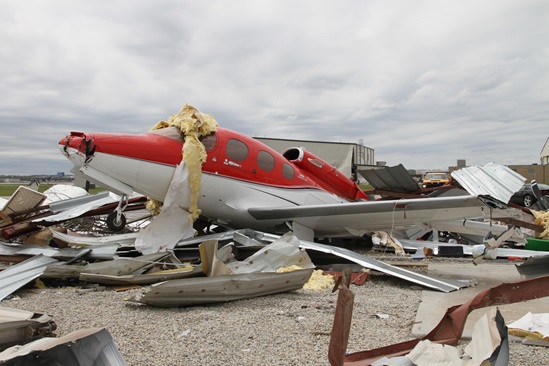Winning Wx apps
Five weather applications worth a look

Some apps are better than others, but the standouts can be valuable tools for staying up to date on the weather—and faster, easier to access, and less tedious than a session at websites or a phone briefing with Flight Service. Here are just a few of my favorites:
 Electronic flight bags (EFBs)/tablet apps.
Electronic flight bags (EFBs)/tablet apps.
Full-featured apps like those from ForeFlight, Garmin Pilot, FltPlan Go, and others are hard to beat. You can file flight plans with them, and METARs, TAFs, and plenty of other airport information can be called up just by touching an airport symbol. Their big-screen displays make it easy to plot flight plans, and profile views can give you a look at a cross-section of the weather along your route. Add ADS-B weather or SiriusXM Aviation Weather capability and you can use EFBs to maneuver around convective radar signatures. Just remember to give them a wide berth. Prices vary. ForeFlight, for example, can run you up to $500 or more per year, depending on the features and coverage areas you select.
MyRadar Pro.
This is good for quick, big-picture evaluations of frontal locations and movements, precipitation returns, cloud formations, pireps, airmets, and sigmets, and even TFRs. General, non-aviation weather is shown for the next two days on sites you save as favorites. Surface wind flows are animated, and you can even opt to show the International Space Station’s progress. Worldwide coverage is another nice feature. Prices run from $29.99 per year for the basic Premium Features package, plus another $24.99 per year for aviation charts.
 WxSpork.
WxSpork.
This app has among the best of the more granular graphic depictions of aviation weather. Once you plot a route, you can see nearly every weather product available for it. This includes METARs, TAFs, seven-day outlooks, in-depth area forecast discussions, and meteograms, which are three-day forecast plots of surface weather and conditions aloft. A sliding indicator pinpoints all forecast variables for each six-hour forecast period, and grid view, route profile, and map views track forecast weather along your route based on your groundspeed. Prog charts, G-airmets, and sigmets are also included. Forecast loops of radar returns from four separate numerical weather prediction models let you compare each model’s latest idea of conditions for today and the following day. As if this weren’t enough, Skew-T Log-P charts are also provided. They let true weather geeks examine the atmosphere to their hearts’ content. Just remember—the more the temperature and dew point traces lean to the left, the more unstable the situation. An initial 14-day subscription is free; after that the monthly fee is $4.99.

Windy.
As the name implies, this app dwells on wind conditions at selected sites. Touch the “wind” logo at the bottom of the screen and you’ll see six forecast model depictions of prevailing winds for the upcoming five days. To make it easier to interpret, individual wind arrows are posted for an airport of interest, bearing labels for each model’s output. The “meteogram” link gives you a meteogram with cloud coverage depictions for altitudes up to FL300, plus surface temperature, dew point, and, of course, wind data. Six weather prediction models evaluate and predict the data, making it easy to compare the variability of each. Want wind barbs for winds aloft? Touch the “airgram” callout and there they are, for the next five days. And like WxSpork, Skew-T Log-P charts are available. A final note: Default values are in Celsius, meters per second (for winds), millimeters (for rain or snow), hectopascals (for pressure), and meters (for altitude). Be sure to go to the settings page to change these to Fahrenheit, knots, inches, inches mercury, and feet if that’s your choice. Windy is free, but a premium subscription is $2.99 per month or $18.99 per year.
They let true weather geeks examine the atmosphere to their hearts’ content.

RadarScope.
For those who have a good understanding of weather radar products and signatures, this is the app for you. It uses the nation’s ground-based Nexrad radar network to show a wide range of variables. In effect, it puts you in charge of each radar’s output, as well as the tilt angles of the radar dishes. It can tell the type and quantity of precipitation, cell contours and gradients, cloud top altitudes, plus the direction and speed of cell movement and movements within a cloud mass. A split-screen feature lets you look at two products at the same time—such as base reflectivity for radar returns closer to the surface, along with composite reflectivity for the heaviest precipitation levels at altitude. One mode—storm relative velocity—depicts tornadic radar signatures. Here, you’d see red shades (for movement away from the radar site) immediately adjacent to green shades (for movement toward the radar), forming what’s called a couplet. Zoom in on it and you might well see cloud rotation. For preflight examination of an area covered by a convective sigmet, this app can’t be beat. It can be pricey, with rates ranging from $9.99 per year for the basic version all the way up to $99.99 per year for the full-featured “ProTier 2” coverage levels.
Having two or three of these apps can give you all you need for both VFR and IFR flying. Did someone say they wanted more Skew-T information? I thought so. Well, you should get SkewTLogPro ($17.99 per year) to really get your geek on.





